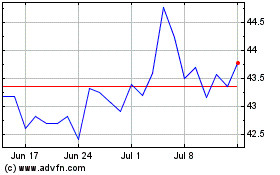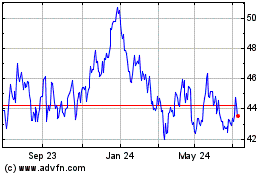Brazil Prosecutors Narrow Dam Probe
November 24 2015 - 7:43PM
Dow Jones News
By Paul Kiernan
RIO DE JANEIRO--A task force of Brazilian prosecutors
investigating a massive dam failure earlier this month are focusing
their inquiry on a series of recently uncovered issues that may
have contributed to the disaster.
The team is scheduled to meet Wednesday with representatives of
the mining companies that own the dam--Brazil's Vale SA,
Australia's BHP Billiton Ltd.--and their 50-50 joint-venture
Samarco Mineração SA federal prosecutor José Adércio Leite Sampaio
said in an interview Tuesday.
The dam that collapsed, named Fundão, had undergone a rapid
scaling-up in recent years. Between 2012 and 2015, the volume of
so-called tailings--detritus from iron-ore plants mixed with mud
and water--grew from 5 million cubic meters to 55 million cubic
meters, Mr. Sampaio said.
"To what point did that compromise the structure?" he said.
In addition, several of the roughly 50 cylindrical instruments
bored into the dam's earthen surface indicated "emergency" levels
of pressure and stress prior to its collapse, Mr. Sampaio said.
Investigators have asked the companies to map out the location of
the devices, known as piezometers, to determine whether they
accurately predicted weak spots in the dam.
A Samarco spokeswoman declined to comment.
Another question prosecutors plan to raise, Mr. Sampaio said, is
whether a contract that allowed Vale to dump waste from its nearby
Alegria iron-ore mine into the Samarco dam was properly licensed
and monitored.
The Wall Street Journal first reported on Nov. 10 that Vale may
have been using Samarco's dam system at the time of the disaster,
but the company didn't confirm the information until this week.
The existence of the contract could raise questions about Vale's
potential liability for the Nov. 5 accident. Both Vale and BHP
Billiton have insisted that Samarco--as an independently run,
limited liability company--was solely responsible for the tailings
dams.
But some legal experts question whether that argument would hold
up in court, especially if Samarco can't cover the costs of
cleanup, fines and damages on its own. Brazilian prosecutors have
said they will go after Vale and BHP Billiton to foot the bill if
Samarco falls short.
"With the confirmation that Vale was depositing, this
responsibility becomes even stronger," Mr. Sampaio said.
In an emailed statement Tuesday, Vale said its contract with
Samarco dates to 2008 but that it accounted for "less than 5%" of
the tailings deposited in Fundão each year.
"The relationship was governed by a contract between the two
companies, which defined Samarco as responsible for the management,
control and operation of these deposits," Vale said.
Authorities, investors and the companies themselves are still
struggling to calculate the extent of the devastation caused by the
dam failure. An avalanche of mud buried entire communities,
destroying ancient colonial churches, killing as many as 12 people
and leaving another 11 missing. The breach also polluted hundreds
of miles of the Rio Doce, a major river.
None of the three companies has provided an explanation for why
the dam system collapsed, and some analysts expect it could be
months before they do so.
In a report published this week, Credit Suisse analyst Ivano
Westin said he doesn't expect Vale to receive any dividends from
Samarco for at least two years. The bank previously expected
Samarco to pay Vale $460 million in 2016 and $417 million in 2017,
accounting for as much as 7% of the mining giant's cash flow.
"The repair of the tailing dam could take 1-2 years," Mr. Westin
said. "However, it remains unclear how long, or even if, Samarco's
operations will be running again as before."
Write to Paul Kiernan at paul.kiernan@wsj.com
Subscribe to WSJ: http://online.wsj.com?mod=djnwires
(END) Dow Jones Newswires
November 24, 2015 19:28 ET (00:28 GMT)
Copyright (c) 2015 Dow Jones & Company, Inc.
BHP (ASX:BHP)
Historical Stock Chart
From Mar 2024 to Apr 2024

BHP (ASX:BHP)
Historical Stock Chart
From Apr 2023 to Apr 2024
